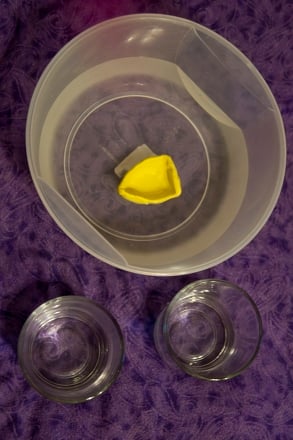Science project
How to Make a Steam Powered Rocket Boat
Steam, which is the gaseous version of water, can be used to power trains, lights in buildings, and your very own model boat! Learn how to make a steam powered rocket boat to see Sir Isaac Newton's third law of motion in action: For every force or action, there is an equal force or action in the opposite direction.
Problem
What conditions make for a better rocket boat?
Materials
- Thick Styrofoam board
- Box cutter
- Ruler
- Cork
- Cigar tube (ask an adult to get one for you) or stainless steel pipe with one capped end
- Wire coat hanger or very thick gauge wire
- 2 Food heating candles or tea candles
- 3 Nails
- Hammer
- Modeling clay
- Water
- Kettle
- Glue or tape
- Lighter or matches
Procedure
- Take thick gauge wire (or an untwisted wire coat hanger) and wrap the front and back cigar tube or steel pipe so the tube is firmly and securely wrapped with equal lengths of wire sticking out from each side.
- Use a ruler to trace a boat shape that is about 4” wide and 7” long on your Styrofoam board. Have an adult use the box cutter to cut out the shape you traced.

- Mount the cigar tube to your Styrofoam board by inserting the wire ends into the Styrofoam. The cigar tube should create a triangle shape with the Styrofoam board.
- Seal the space between the Styrofoam and the wire with modeling clay to prevent leaking.

- Drive two nails into the front and back of the Styrofoam board and seal with play-doh. What purpose do the nails poking through the bottom serve?
- Glue or tape the candles to the Styrofoam directly under the cigar rube or steel pipe.
- Using a hammer and nail, create a small hole through the center of the cork.
- Have an adult boil some water and let it cool slightly.
- Add ½ cup of hot water to the cigar tube or pipe.
- Cap the cork snuggly on the end of the cigar tube or pipe.

- Light the candles.
- Put the boat in the water and record your observations.
- Make the hole in the cork slightly larger and repeat steps 7 through 11. How does a larger hole in the cork contribute to the rocket’s power?
Results
The boat will move the fastest when the hole is smallest.
Why?
Pouring hot water in the tube and then heating it with tea candles will cause the water to vaporize and turn to steam. The steam, which is a gas, expands and escapes through the hole at a velocity proportional to the size of the hole. Because very action has an equal and opposite reaction, the boat will move forward as the steam pushes out of the end of the tube.
Going Further
Part of an equation called the “Continuity Equation” gives us the following:

Where A is the cross-sectional area (or the size of the hole) and v is the velocity that fluid comes out. Rearranging this equation shows that the smaller the hole is, the higher the velocity.

Driving nails through the bottom of the Styrofoam board helps to stabilize the boat. It works a lot like the hull of a ship or a deep rudder.
Education.com provides the Science Fair Project Ideas for informational purposes only. Education.com does not make any guarantee or representation regarding the Science Fair Project Ideas and is not responsible or liable for any loss or damage, directly or indirectly, caused by your use of such information. By accessing the Science Fair Project Ideas, you waive and renounce any claims against Education.com that arise thereof. In addition, your access to Education.com's website and Science Fair Project Ideas is covered by Education.com's Privacy Policy and site Terms of Use, which include limitations on Education.com's liability.
Warning is hereby given that not all Project Ideas are appropriate for all individuals or in all circumstances. Implementation of any Science Project Idea should be undertaken only in appropriate settings and with appropriate parental or other supervision. Reading and following the safety precautions of all materials used in a project is the sole responsibility of each individual. For further information, consult your state's handbook of Science Safety.













